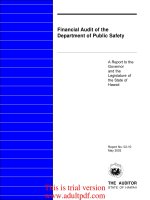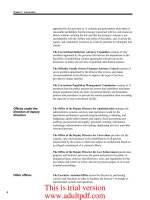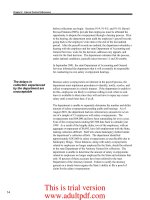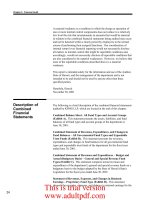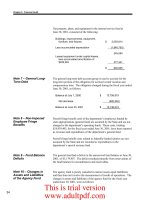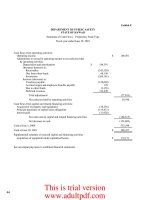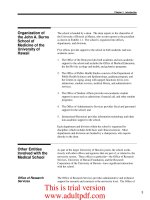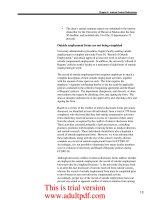FINANCIAL AUDIT First Audit of the Library of Congress Discloses Significant Problems _part6 docx
Bạn đang xem bản rút gọn của tài liệu. Xem và tải ngay bản đầy đủ của tài liệu tại đây (956.63 KB, 10 trang )
Appendix Iii
CauolMatd Stet8ment of Pinancial Poeition
of
the Library of Congreen for the Fiscal Year
Enfling September 80,1999
Future Minimum Lease Payments
Fiscal year ending:
1989
1990
1991
1992
1993 and beyond
Amount due
(in
thousands)
$ 4,598
4,482
3,141
1,011
Total minimum lease payments
ad
Less:
Executory costs
1,589
Amount representing interest
1,789 3,378
Net Obligations Under Capital Leases
$
Note 12: Accounts Payable
Accounts payable consists of amounts due to the vendors and other
agencies for goods and services received prior to the end of
fiscal year 1988. It includes about $13.7 million owed to
contractors for providing data base retrieval and other library-
related services to other federal agencies at the request of the
Library of Congress. It also includes other miscellaneous
payables.
The next table shows the composition of accounts payable at the
end of fiscal year 1988.
Accounts Payable as of September 30, 1988
Accounts Payable Amount
(in thousands)
Accounts payable - public $24,603
Accounts payable -
other federal agencies
530
Other miscellaneous payables
Total
150
$25,283
Note 13:
Amounts Due to the Treasury
This liability represents revenues the Library received in fiscal
years 1987 and 1988 in excess of amounts it was authorized to
retain and,
as of fiscal year-end, had not transferred to the
Treasury as required.
In fiscal year
1988,
the Library was
authorized to retain $5 million of the revenues it collected for
catalog distribution services. It recognized revenues for these
services that exceeded this authorized level by $1.4 million.
Since the Library is not authorized to retain this amount, it is
reportable as miscellaneous receipts due to the Treasury.
Page 49 GAO/AFMD-91-13 First Audit of the
Library
of Congress
This is trial version
www.adultpdf.com
Appendix III
Ckmsolidated Statement of FInanchl Position
of the Library of Ckmgreoa for the Pkal Year
Ending &ptember 30,1999
Note 14:
Advances From Others
Advances from others consists of amounts collected from federal
agencies
and
the public under the Library's reimbursable programs
for
a
variety of services not yet provided.
The table below shows
the nature of the advances from others at
1988
fiscal year-end.
Advances From Others as of September 30,
1988
Advances
Amount
(in thousands)
Data base services
$43,160
Photoduplication services
529
Bibliosraphical services
1,439
Copyright-services
Total
1,371
$46,-499
Note
15:
Invested Capital
Invested capital represents U.S.
Government
resources
invested in
certain Library assets. The $64 million year-end balance consists
mainly of the undepreciated value of capital assets including
property and equipment, certain other minor assets, and related
adjustments made as of September 30,
1988.
Note 16:
Unexpended Appropriations
Unexpended appropriations consist of unobligated balances and
undelivered orders.
Unobligated balances represent amounts
appropriated which are unobligated and have not lapsed, been
rescinded, or been withdrawn.
Undelivered
orders
represent obligations the Library had incurred
as of September 30,
1988,
for goods and services which were
ordered
but
had not been received by that date.
Undelivered
orders include
amounts
for orders or services for which
reimbursement to the appropriation has not yet been recognized.
Advance payments from customer agencies are recognized as a
liability (see note 14) and are shown as unfilled customer orders
which reduce unexpended appropriations.
The next
table shows
unexpended appropriations at the end of fiscal year
1988.
Unexpended Appropriations as of September 30,
1988
Type
Amount
(inmrllions)
Unobligated balances
Undelivered orders
Unfilled customer orders
Total
$ 25.5
91.6
(43.8)
$73.3
Page 60 GAO/AFMD-91-U First Audit of the Library of Congress
This is trial version
www.adultpdf.com
Appendix III
Cxmsolidated Statement of Financial Position
of the Library of Ckmgress for the Fiscal Year
Ending September SO,1988
-
Note
17:
Cumulative Results of Operations
The balance shown represents the cumulative deficit arising from
the Library's general fund operations.
Approximately $454,000 of
the $574,000 deficit reported as of September 30, 1988, is a
KeSUlt of fiscal year 1988 operations. The remaining balance is
the result of operations in prior years.
These losses occurred in
the operation of the Library's reimbursable programs; however,
because the Library lacks adequate accounting and financial
management systems to properly track the cost of operating its
programs and to accurately identify certain of its revenues, it
could not determine which of its reimbursable programs experienced
the operating deficits.
Note
18:
Subsequent Events
As of September 30,
1989, a significant portion of the
reimbursable work which the Library's Federal Research Division
performs for the Department of Defense was terminated.
With this
funding no longer available from the sponsoring agency, the Library
found it necessary, in February 1990, to conduct a reduction in
force fOK its employees who had worked on the Department of Defense
projects. The Congress, in its conference report on appropriations
for the legislative branch (H. Rept. lOl-254), directed the Library
to delay this action past the end of fiscal year 1989 while it made
funds available to allow the Department of Defense to continue
these Library services.
However,
after receiving its
appropriations, the Department of Defense decided not to renew its
contracts for these services.
This decision, coupled with the congressional directive, resulted
in the Library incurring
$912,000
in fiscal year 1990 costs, for
these employees.
Since these employees were hired specifically to
work on the sponsoring agency's contracts, it was the Library's
position that the $912,000 should be reimbursed by the sponsoring
agency, but DOD refused to fund these costs.
However, the 1991
Department of Defense Appropriations Act (Public Law 101-511,
November 5,
1990) specifies that $912,000 of the Operation and
Maintenance,
Defense Agencies appropriation is available only fOK
transfer to the Library of Congress.
Y
Page 51
GAO/AFMD91-13 First Audit of the Library of Congress
‘_
This is trial version
www.adultpdf.com
Appendix III
Consolidated Statement of Flnandal Position
of the Library of Congrese for the Fiscal Year
Ending September 90,1999
Note 19: Schedule of Assets, Liabilities, and Equity by Fund Type. as of September 30. 1988
Genera I
funds
Serv ice
fee
Gift and
funds
trust funds
Consolidated
(dollars In thousands)
Assets
Funds with U.S. Treasury (note 3)
5121,964
S4.182
S 6,353
$132,499
Accounts Receivable, Net (note 4)
34,712
146 195 35,113
Permanent Loan to U.S. Treasury (note 5)
5,040 5,040
Investments (note 6)
326,251 326,251
I nventor les ( note 7 I
1,539
361 1,900
Future Appropr lat Ions (note 8)
9,878
9.070
Library Collection (note 9)
Property and Equipment, Net of
Accumulated Dspreclatlon (note 10)
72,269
308 72,577
Other Assets
135 135
Due From Other Llbrary Funds
(247)
243
4
Total Assets
S240,175
c
SU S337.906 5583,401
Llabilltles and Equity
L lab I I it ies
Accounts Payable (note 12)
4 24,900 S 232
S 151 S 25,203
Amounts Due to Treasury (note 13)
1,449
1,449
Accrued Payrol I and E!enef Its (note 1 I
11,646
191 28 11,865
Accrued Ann ua I Leave
9.070
139 IO,01 7
Advances From Others (note 14)
45,970
529 46,499
Obl lgatlons Under Capital Leases (note 11)
9,855
9,855
knounts Due Copyrlght Owners (note 6) 321,555 321,555
Due to Other Llbrary Funds
(19)
19
Total Llabll ItIes
103.679 1.091
321,753 426,523
Equity of the U.S. Government
Invested Capital (note 15)
63,756
63,756
Unexpended Appropr iat Ions ( note 16 I
73,314
73,314
Cumulative Results of Operations (note 17)
(574)
(574)
Fund Ba I antes
4.149
16,233 20,382
Total Equity of the U.S. Govarrrart
136,496 4.149
16,233 156,878
Total Llabllltles and Equity
5240,175 $5,240
6337,906 6583,401
Page 52
GAO/AFMD-91-13 First Audit of the Library of Congress
This is trial version
www.adultpdf.com
Appendix IV
Comments From the Library of Congress
Note: GAO comments
supplementing those in the
report text appear at the
end of this appendix.
See comment 1
Y
s
VQrs8
r
THE LIBRARIAN OF CONGRESS
*
0
0
z
WASHINGTON. DC. 20540
v-
2
3
b
c
July 5, 1991
Dear Mr. Chapin:
Thank you for
the
opportunity to review and comment on the General
Accounting Office (GAO) draft report entitled First Audit of the Library of
Congress
Discloses Significant Problems.
As you are aware, I requested this
audit shortly after teking office to obtain an independent assessment of the
Library's financial condition
at
the time I assumed responsibility for its
operations.
GAO's draft reaffirms the steps we are taking to improve the Library's
financial activities,
and the draft's findings parallel those contained in
reports issued by the Library's Transition Groups and the Inspector General. As
noted in
your
draft.
we have not waited for GAO's written report to rectify
problems and are continuing to take steps to correct the deficiencies identified
during the audit.
In fact, my comments will serve to document for the record
steps taken since 1988 to improve financial policy and direction, to bring the
Library's enormous collection of 97 million items under bibliographic and
physical control, to correct deficiencies in the Federal Library and Information
Network (FEDLIMO program, and to request modern statutory authority to conduct
fee service activities.
Chief Financial Officer
The Library's financial management system problems have built up over a
period of years as a result of inadequate management attention and insufficient
resources.
We have taken a number of actions to improve financial direction.
First.
I have strengthened the Library's accounting and financial management
functions by restructuring the central management services and by appointing
professional financial managers to the key positions of Associate Librarian for
Management. who reports directly to me. and Director of Financial Services. who
reports to the Associate Librarian for Management.
Both of these senior managers
are certified public accountants, with extensive backgrounds inFederal financial
management systems.
The Director, Financial Services functions as the Library's
Chief Financial Officer (CFO) by overseeing the day-to-day financial operations
and providing policy advice through the Associate Librarian for Management to the
Library's Management Team. The Library's Management Team is responsible for
making policy.
Members include myself. the Acting Deputy Librarian of Congress,
and the eight Associate Librarians who head up each of the Library's Service
Units.
Second, we developed a financial management plan to accomplish the maximum
level of improvement possible in the shortest time possible, while at the same
time, planning and establishing long-term plans and goals for an effective,
integrated financial management system.
Third. I issued a Library of Congress
regulation that sets forth financial policy. responsibilities, standards. and the
requirement for annual reviews of financial operations.
Page 63
GAO/AFMD-91-13 First Audit of the Library of Ckmgmss
This is trial version
www.adultpdf.com
Appendix IV
Commenta From the Library of Congress
As stated in the draft, it is going to teke 'Ia sustained effort nnd
additional resources over a number of years
'I before all of the problems GAO noted
are fully corrected.
The Library's fiscal 1992 budget request includes
additional resources to strengthen financial controls and operations including
funding for professional accountants, systems analysts, inventory management
specialists,
and collections technicians. I agree with GAO that additional
resources are an essential part of correcting the Library's long-standing
financial management problems.
Control of the Library's Collections
Our top priority is bringing the Library's collections under bibliographic
control sowe can make thisunique and irreplaceable national treasure accessible
while we safeguard its use. We received a substantial appropriation in fiscal
1991 to begin the very lengthy process of cataloging arrearages. Once we have
a complete catalog, we will have the basic inventory we need to control and track
the movement of items in the collections.
Until this task is completed, we
cannot realistically or productively attempt to put a financial value on the
collections.
Federal Library and Information Network (FBDLINC) Program
The bulk of the findings and recommendations contained in the draft are
directed to problems in the FEDLINK program.
FEDLINK is a program, operating
under the Economy Act, designed to support the Federal Library and Information
Center Community (FLICC) in the cost effective procurement of books, serials, and
computer-based information retrieval services for more than 1.400 FEDLINK
members.
In a press release dated March 10.
1989. I announced that the Library's
Inspector General found that certain agencies were using the FEDLINK program to
contract for services without competition services which were not within the
scope of the FEDLINK program.
Prior to any of GAO's findings, I set in motion
actions to change FEDLINK operations substantially.
As a result, most of the
deficiencies mentioned in the GAO draft have been completely corrected and steps
are being taken to correct the remaining items.
Improvements include ensuring
that Federal contracting and competition procedures are strictly followed. that
only authorized services are offered to FLICC members, that obligations do not
exceed available amounts and are properly documented, and that funds are
accounted for in accordance with the law.
However. administration of this $50
million reimbursable program under the authority of the Economy Act remains
difficult because of the requirement to conduct program activities one year at
a time.
Under the authority of a revolving fund, we will be able to establish
reserves and set rates to ensure the viability of the program over the long term.
Therefore,
the Library has included the FEDLINK program in the proposed Library
of Congress revolving fund.
Page 64
GAO/AFMD-91-13 First Audit of the Library of Congress
This is trial version
www.adultpdf.com
Appendix IV
Commenta From the Library of Ckmgress
Revolving Fund Legislation
On May
24. 1991.
I transmitted draft legislation to the House
Administration Committee and the Senate Committee on Rules and Administration
that will provide a modern authorization and fiscal structure for the various
Library products and services that have long been supported by fee service
charges. As you are aware,
a prwious GAO report.
in 1980, made a similar
reccmmendation.
after which the Library initiated legislation to amend the
Library of Congress Trust Fund Board Act (2 U.S.C. 160) to clarify its authority.
In response, the Library received a letter from the Vice-Chairman of the Joint
Committee on the Library indicating that the Library had not exceeded its
authority. I believe the draft legislation will put in place the modem fiscal
structure recommended by GAO and will enable the Library to provide specialized
services requested by the educational and information communities.
I am counting
of your support for enactment of this legislation.
Finally. we believe that the Library's records show our compliance with the
1988 Legislative Branch Appropriations Act, which limits the number of employees
paid from administrative working funds (AWF) to 65.
The Library's records
clearly distinguish between employees paid from AWF and employees paid from the
direct cost reimbursements received from the reimbursable programs.
These
records document that employees paid from monies received to reimburse indirect
costs (AWF) have never exceeded the statutory limit.
While we have made progress in improving theLibrary's financial management
since 1988. a number of major steps still remain,
including upgrading the
Library's outdated. partially automated central accounting system.
As you are
aware, this is a major task requiring a substantial investment in resources. The
GAO audit alone took several staff years to complete and was a significant
investment of your resources.
I look forward to continuing to work with GAO on
this important task. I am confident that with the support of Congress. we can
continue to make progress and put in place a system that fully meets Federal
standards.
The enclosure presents a detailed
response to
the
findings
and
recommendations in the draft.
Since ely.
r-
Enclosure
Mr. Donald H. Chapin
Assistant Comptroller General
United States General Accounting Office
441 G Street, NW
Washington, DC 20548
Page 65 GAO/AFMD-91-13 First Audit of the Library of Congress
This is trial version
www.adultpdf.com
Appendix lV
Comment4 From the Library of Cmgrem
July 6, 1991
LIBRARY OF CONGRESS’ RESPONSE TO GAO’S AUDIT
FINDINGS AND RECOMMENDATIONS
. I
m The Library’s internal control policies and procedures governing the
accounting and reporting of financial management information were not uniformly
prescribed, documented, or followed.
of Cw (LC!) w The Library has developed a long-term plan and
set goals for improvement of ita financial management system. The plan uses a
“building block” approach towarda financial management improvement beginning with
a regulation which epecifiee the Library’s internal control policies and accounting
etandarda, and assigns responeibilitiee and requirements for annual reviews and
reporte of Library operations. The Library has initiated a system of financial services
directives to communicate the policies, standards, and procedures to the Library’s
financial systema managers.
. *
Gd\O: The Library’s Financial Management System is not complete or
integrated.
m: Aa stated above, the Library has taken steps to centralize control over
the financial management system by implementing and communicating centralized
policies, standards! and procedures and ensuring that they are observed. The Library
has initiated a Financial Management System Improvement Project to document
accounting requirements and information needs for a fully integrated system, to
evaluate alternatives and develop options for improvement of the Library’s outdated,
partially automated central accounting system, and to assist with implementation
taeka. To staff this effort, the Library’s fiscal 1992 budget includes a request for
additional funding for systems accountants and analysts.
a .
MO Ibsubu
: General Ledger Control Accounts were not routinely reconciled with
subsidiary records.
m: The two program financial syetema that GAO found were not routinely
reconciled with the central accounting records are being evaluated for improvement,
including the eetablishment of automated interfaces and procedures to ensure
adequate reconciliations. The Library has aleo requested three operating accountants
in its 1992 budget requests to improve the timeliness of reconciliations.
. .
GAO Mdu~
: FEDLINK contracts were not limited to the program’s purposes.
m: The Library hae instituted procedures to ensure that only authorized
services are provided to FEDLINK’s members and participants.
For example,
FEDLINK solicitations include an explicit list of services which are excluded from
awards under both the delegation of procurement authority (DPA) and non-DPA
service categories. Among the excluded services are the provision of equipment for
sale or lease, development or customization of eoftware or database systems, generic
Page 56 GAO/AFMD-91-13 First Audit of the Library of Congress
This is trial version
www.adultpdf.com
Appendix IV
Comments From the Library of Congrese
automatic
data
processing applications, and personnel or consulting services. Review
by the Technical Panels and LC Contracting Officers and formal certification by the
offeror0 themselves ensures that such eervicee are not included in LC/FEDLINK
agreements.
6.
. .
[3AO The Library’s authority to award FEDLINK ADP contracts cannot be
verifled.
m: See Report on Compliance with Laws and Regulations, Item 7.
6.
m FEDLINK services provided exceeded available amounts.
m~emonse: Since flacal year 1990, the Library
has enforced
the requirement that
no service kom vendors to agencies is authorized without a current Interagency
agreement (IAGI and valid delivery order. Strict enforcement of thie policy ensures
that amounts obligated will not exceed obligational authority.
7.
QAO Finding: FEDLINK firnde were expended without regard to period of
availability.
m: See Report on Compliance with Laws and Regulations, Item 1.
8.
. .
m.~lndrnn: FEDLINK obligations were not based on proper documentation,
m: In 1990, the Library revised its procedures to record only obligations
made
to vendors through signed “Notices of Obligation/Change in Obligation of
Funds.
These notices are generated from the FEDLINK Financial Office (FFO)
automated system after
receipt of copies of signed delivery orders. Attached to each
vendor-specific notice is a detailed list of agencies and individual obligated amounts
to be included in the overall obligation.
In this fashion, the Financial Services
Directorate (FSD) is notified of obligations on an agency-specific basis and can be
assured that obligations are based on valid documents.
9.
. .
SAO Flndme
: FEDLINK contracts were not authorized by responsible official.
m: Beginning in fiscal year 1990, all FEDLINK orders are issued by
contracting officers, and all transfer pay orders are signed by a duly authorized
contracting officer. Vendors and customers have been notified that no order exists
and
that no service is authorized until an order has been signed and issued by a
contracting officer.
. .
10. QAO Fw
: The Library collection and other property and equipment are not
controlled.
m: In its fiscal year 1991 budget, the Library requested and received
additional resources to reduce the arrearage of uncataloged collections. The Library
has developed an arrearage management plan which will place an additional large part
of the Library’s collections under bibliographic control. Also, the Library has
implemented an automated Collections Control Facility (CCF) which locatee and tracks
the movement of items in the Library’s collections. The Library continues to expand
the CCF to include more and more bibliographic records which increasee significantly
Page 67 GAO/AFMD-91-13 First Audit of the Library of Ckmgrese
This is trial version
www.adultpdf.com
Appendix IV
Commentu Fkom the Library of Congress
the ability to control the collections.
In addition to the arrearage project and the CCF, the Library has been conducting an
inventory of the cataloged collections, and, a~ a result, is able to provide accurate
counta for the classes which have already been completed. When the first pass
through the collections is completed, in approximately 6 years, the count will begin
again. The purpose of the inventory ie to enhance the retrievability of the Library’s
general collection through correcting bibliographic errors and accounting for each
physical item aa represented in the Library’s official shelflist. The inventory is now
approximately 90% complete.
Other steps have also been taken to increase the physical security of the collections
such aa requiring staff to wear identification cards at all times, a user card program
to be implemented in June 1991, and a theft detection system for which the Library
ie now receiving bids.
Since it ie a top priority in the Library to achieve the maximum possible control over
ite collections, resources have first been allocated to cataloging, securing and making
the collections accessible to the users. While developing and maintaining a financial
value of the collections is a current GAO requirement, it is also true that the Federal
accounting community haa not reached an agreement on how accounting for national
treasures should be accomplished.
Until the task of cataloging the collections is
completed, we cannot realistically or productively attempt to put a financial value on
the collections.
In ita fiscal year 1992 budget, the Library requested funding for two GS-7 inventory
management specialists to develop an inventory system for the furniture and non-
serialized equipment (equipment with no serial number applied by the manufacturer).
We anticipate the process will take three years and will include a physical count,
labeling, classification, appraisal, records research, data entry, and reconciliation.
. .
11. Q,$O Flndu
: Accounts receivable and advances from government agencies were not
determinable.
m: Since fiscal year 1990, the Library haa changed its year-end procedures
to adjuet for the accounts receivable and advances from government agencies. Also,
since fiscal year 1990, the amount of unpaid accounts in the FEDLINR program haa
declined considerably becauee the Library no longer provides FEDLINK services to
delinquent customers. Therefore, the unpaid balances now range between $4 and $10
million and are only outstanding for short periods of time. Due to system constraints,
low priority, and the lack of resources, the Library does not maintain this information
on a monthly basis.
12.
. .
GAO Fi&&ng : The payment process was not controlled.
LC Rem: The Library hae a manual accounts payable system. While all
obligations are promptly recorded, the accounting records are adjusted only once each
year to reclassify that part of obligations which are actually payable.
Implementation
of an automated accounts payable system ie part of the Library’s long-term financial
management improvement plan and will provide the ability to record payables on a
more frequent basis.
Page 58
GAO/AFMD-91-13 First Audit of the Library of Congress
This is trial version
www.adultpdf.com
